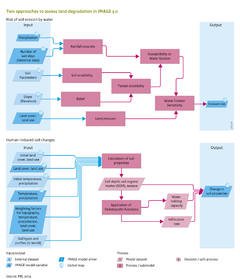Land degradation/Description: Difference between revisions
Jump to navigation
Jump to search
Oostenrijr (talk | contribs) No edit summary |
Oostenrijr (talk | contribs) No edit summary |
||
| Line 59: | Line 59: | ||
Soil degradation is mostly reflected in changes in soil properties, such as soil depth, soil organic matter ({{abbrTemplate|SOM}}) content, and texture. Land cover and land use drive changes in soil properties. Land cover protects the soil against wind and water erosion, and provides organic matter to the soil. Land use tends to remove part of the biomass with harvested crops and residues and may increase mineralisation of SOM through tillage. | Soil degradation is mostly reflected in changes in soil properties, such as soil depth, soil organic matter ({{abbrTemplate|SOM}}) content, and texture. Land cover and land use drive changes in soil properties. Land cover protects the soil against wind and water erosion, and provides organic matter to the soil. Land use tends to remove part of the biomass with harvested crops and residues and may increase mineralisation of SOM through tillage. | ||
An empirical model denominated S-World has been developed that relates change in soil properties to topography, climate (average annual temperature and total annual precipitation), land management and land use, and land cover (as vegetation cover) ([[Stoorvogel, 2014]]; [[Stoorvogel et al., | An empirical model denominated S-World has been developed that relates change in soil properties to topography, climate (average annual temperature and total annual precipitation), land management and land use, and land cover (as vegetation cover) ([[Stoorvogel, 2014]]; [[Stoorvogel et al., 2017]]). The following soil properties are considered: | ||
* topsoil depth, | * topsoil depth, | ||
* soil depth, | * soil depth, | ||
Revision as of 11:47, 13 June 2018
Parts of Land degradation/Description
| Component is implemented in: |
|
| Related IMAGE components |
| Projects/Applications |
| Models/Databases |
| Key publications |
| References |
